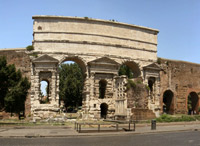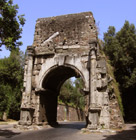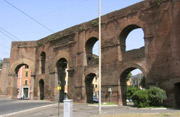The Roman aqueducts stand today, more than two thousand years later, as a testament to the engineering genius of the ancient Romans. These massive structures not only boggle the human mind as to how they were constructed, but their function and reliability are still a modern marvel.
In fact, some aqueducts remain operational to this day. Walking through the modern city of Rome, one will come across these monumental arched structures that often cross streets and avenues. Sometimes these arches are doubled and often ornately decorated. Three such arches visible to the general traveler in Rome are the Porta Maggiore, the Arch of Drusus, and Nero’s Aqueduct.
What Were Aqueducts Used For?
The Roman aqueducts not only provided drinking water for the Romans but indoor sewer systems that carried water away from the city and also supplied the bath houses with ample water, where the inhabitants of ancient Rome spent so much of their leisure time.
How Does an Aqueduct Work?
The bulk of the Roman water system ran below the city, burrowed through 260 miles of rock, and about 30 miles of above-ground bridges and crossways (the arches). The entire system relied on various gradients and gravity to maintain a continuous flow.
The water rushed from the higher ground via the ducts and emptied into giant cisterns in the city. These cisterns then distributed the water through lead pipes which reached most of the city.
At approximately the height of Rome’s population, 1 million inhabitants, the ducts provided up to 1 cubic meter of water for every person. There are eleven such aqueducts that supplied the ancient city of Rome, dating as early as 140 B.C. and spanning five hundred years.
Maintenance of the Aqueducts
Maintenance of the ducts was a constant job being tended to by first, a paid curator, and then often labour slaves. The Roman legions were also required to build and dig in areas far from the city of Rome itself as they proceeded to conquer and inhabit further regions of the empire.
Destruction and Restoration
Towards the last days of the Roman Empire many of these Aqueducts were destroyed by invading German tribes as they sought to cut off Rome’s water supplies. The ducts were left in disrepair until the Renaissance, when many were restored.
Engineering
Some emperors were especially interested in the engineering of these structures and their ability to bring water to the city and growing provinces of the empire.
Porta Maggiore

One such emperor was Claudius. He is associated with the Porta Maggiore, a double-arched aqueduct still standing over two important ancient roads, the Via Praenestina and the Via Labicana.
This structure might look to some extent unremarkable, despite its size, but the emperor had deliberately left the bottom half of the arch rough and somewhat undecorated in the style he preferred. So, the stones that we see today have not been smoothed or processed since their excavation from the ancient quarry.
The Porta Maggiore carried water from the springs in the upper valley of Anio and reached Rome after traveling 68 kilometers. This aqueduct alone provided the city with 2/3 of its water supply. That is a greater number than what is even available today in many modern cities.
Arch of Drusus

In addition to the Porta Maggiore, the Arch of Drusus(Aqua Antoniniana) is located 1/2 mile east of Caracalla’s baths.
It was originally part of a larger aqueduct that was improved upon by the emperor Caracalla(211-217 A.D.) when he added a second channel in 212 A.D in order to supply his baths 91 Kilometers away from its primary water source.
The aqueducts yielded 190,000m3 of water per day.
Only the Arch itself, which crosses the Via Appia, is visible today, as the ducts themselves have long since disappeared.
Nero’s Aqueduct

Another structure worth noting is Nero’s Aqueduct(Arcus Neroniani), built by the emperor Nero(54-68 A.D.), which drew water from Claudius’ aqueduct and ushered it to Nero’s imperial palace(Domus Aurea/Golden House).
It is located on the present Via Statilia and can be seen in bits and pieces starting from the Porta Maggiore on through to the Palatine Hill.
The Visibility and Efficiency
One of the reasons the Aqueducts are visible above ground is that the Romans were known for efficiently getting sources from one point to another in the least amount of time and distance. This helps explain the monumental archways and bridges of the Aqueducts we see traverse throughout the city.
When the surface structure of the land was unable to accommodate underground tunnels, such as valleys and rivers, the Roman aqueducts were built above ground so that nothing, neither mountain nor water, dictated their path. They simply built over, under, or through the obstacle.